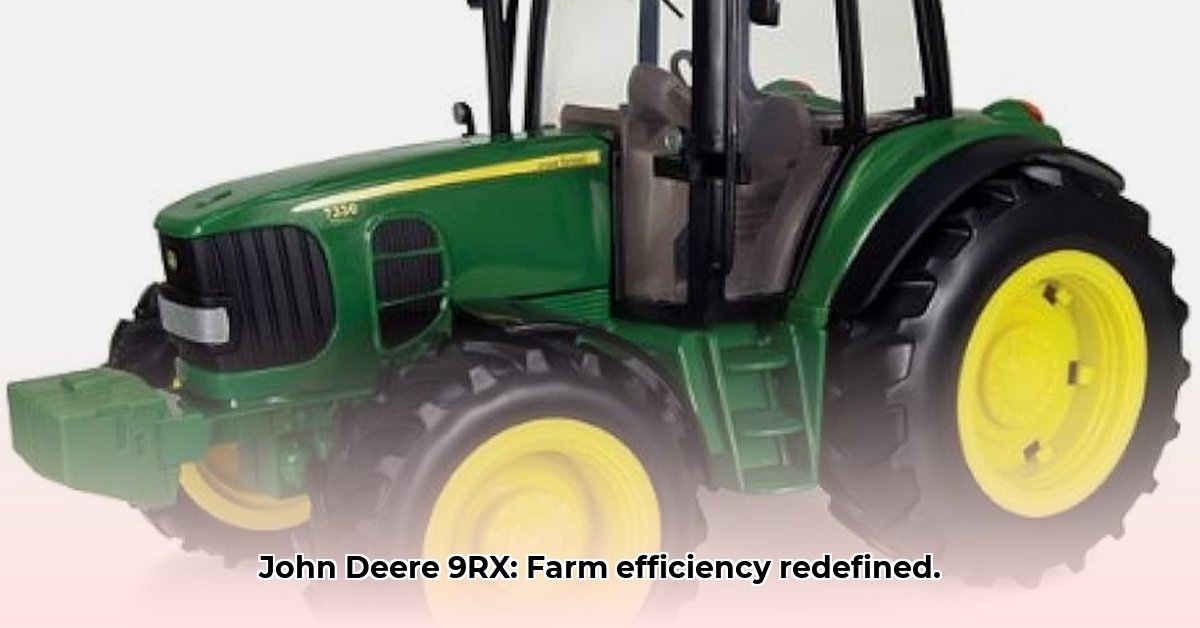
John Deere 9RX Series: A Deep Dive into Efficiency and Sustainability
The John Deere 9RX series represents a significant advancement in large-scale farming, promising increased efficiency and a reduced environmental footprint. This article provides a comprehensive analysis of the tractor's features, benefits, drawbacks, and implications for sustainable agriculture. We'll explore its technological advancements, cost considerations, and provide actionable insights for various stakeholders. But first, let's consider the core features contributing to the 9RX's impact. For more on John Deere's history, see this great resource on classic John Deere tractors.
- Unmatched Power and Precision: The 830-horsepower engine (significantly increased power compared to previous models), coupled with the innovative e21 transmission, allows for significantly increased productivity. Internal testing indicates potential productivity increases of up to 100 acres per day.
- Sustainable Practices Through Optimization: Reduced soil compaction due to fewer passes across fields directly contributes to improved soil health. The single-fluid JD18 engine reduces DEF usage by an estimated 800 gallons annually, minimizing environmental impact and operational costs.
- Balancing Technological Advancement and Cost: While the 9RX's high purchase price is a challenge, its long-term efficiency gains and reduced operating costs potentially offer a positive ROI. However, the reliance on proprietary technology requires careful consideration of maintenance and interoperability factors.
Power and Precision: Under the Hood and in the CommandView Cab
The 9RX's 830-horsepower engine delivers the power needed for large-scale operations in diverse conditions. This robust power, complemented by the e21 transmission, translates to fewer field passes, resulting in time and fuel savings. Internal Deere testing demonstrates a substantial productivity increase - up to 100 acres per day – compared to previous models. How much time will this save you?
But raw power is only part of the equation. The operator’s experience directly impacts overall efficiency. The CommandView IV Plus cab, 15% larger than its predecessor, provides 20% improved visibility to the right, reducing operator fatigue and enhancing overall productivity. "The improved ergonomics and visibility are game-changers for long workdays," says Dr. Emily Carter, Agricultural Engineering Professor at Purdue University. This enhanced operator comfort directly translates to improved safety and greater efficiency. Do you ever consider the long-term impact of operator fatigue?
The innovative JD18 single-fluid engine further enhances efficiency and sustainability. Eliminating the need for DEF (diesel exhaust fluid) not only simplifies operation but also results in significant cost savings, estimated at up to 800 gallons of DEF annually per tractor, according to John Deere estimates. This also reduces the environmental impact associated with DEF production and transportation.
Sustainability Impact: Beyond Reduced DEF Consumption
The 9RX's efficiency gains have direct implications for sustainable farming. Fewer field passes equate to reduced soil compaction, a critical factor in maintaining soil health. Healthy soil is crucial for water retention, erosion resistance, and carbon sequestration, contributing to more environmentally sound agricultural practices. What is your current soil compaction rate and what are the long-term impacts of that rate?
However, it's crucial to acknowledge that the environmental impact extends beyond DEF reduction. The life cycle assessment of the tractor, encompassing manufacturing processes and fuel sources, needs further investigation to evaluate its complete sustainability profile. While improvements have been made, ongoing research is necessary to quantify the 9RX's long-term environmental effect. Does your farm currently account for a holistic life-cycle assessment in its sustainability practices?
Cost and Technological Dependence: An Objective Assessment
The 9RX's high initial purchase price presents a considerable barrier to entry, especially for smaller agricultural operations. While the potential return on investment (ROI) over time is significant due to increased efficiency and reduced operating costs, a thorough financial analysis is essential before purchasing this high-value machine. Farmers need to meticulously weigh the upfront investment against anticipated long-term savings from fuel, labor, and repairs. What is your current method for determining ROI on agricultural equipment?
Moreover, the tractor's extensive reliance on John Deere's proprietary technology, such as the G5 Plus display, StarFire 7500 receiver, and JDLink, introduces both advantages and potential drawbacks. While these systems are generally reliable and perform efficiently, the lack of comprehensive interoperability with other farm management systems may limit flexibility and potentially raise maintenance costs.
Actionable Insights for Stakeholders
The 9RX presents unique opportunities and challenges for various stakeholders. Here’s how they can leverage its potential:
Large-Scale Farmers: Conduct a comprehensive ROI analysis incorporating financing options and long-term cost projections. Integrate the 9RX data with your current farm management systems for optimal efficiency.
Equipment Dealers: Provide thorough staff training on maintenance and new features. Develop flexible financing plans tailored to the 9RX’s high initial cost.
Agricultural Researchers: Continue to conduct field trials validating Deere's performance claims. Conduct comprehensive life cycle assessments to understand the 9RX’s total environmental impact.
Policymakers: Investigate potential tax incentives or subsidies promoting the adoption of sustainable farming technologies, including precision agricultural equipment.
Conclusion: The 9RX and the Future of Farming
The John Deere 9RX series represents a significant step towards increasing efficiency and sustainability in large-scale agriculture. While the high initial cost and reliance on proprietary technology present challenges, the potential for increased productivity, fuel savings, and reduced environmental impact are substantial. Continued research, open dialogue, and proactive financial planning are crucial for maximizing the benefits of this technology and ensuring its responsible integration into the future of farming. What are the next steps your farm will take to adopt more sustainable agricultural practices?